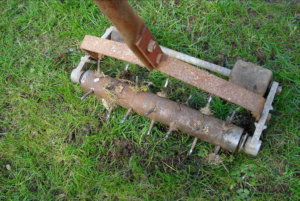
ATTRIBUTION: allispossible.org.uk (Flickr)
The start of fall is the best time to prepare your lawn for the long winter ahead. Without help, most lawns will not survive snow, ice, and extreme cold intact, so when spring finally arrives, you may find that your beautiful lawn isn’t so beautiful anymore. Before the ground freezes, I recommend performing a few fall maintenance tasks to prepare your lawn for the next growing season.
1. Clear Debris
Items strewn across the lawn can prevent the soil from “breathing.” Start by picking up any debris, such as broken tree limbs, grass clippings, dropped leaves, and dead plants. If you leave debris to accumulate, it will often smother the grass, resulting in dead patches. Bag dry, loose leaves and leave them at the curb for pickup if this service is available in your area. You can also compost loose leaves.
Besides leaves and twigs, also take the time to remove thatch (dead grass that collects at the base of the lawn) and harmful fungi. If you allow debris to sit on your lawn and collect moisture from rain, bacteria can breed, causing damage to the lawn and nearby plant life. Go over the entire surface of your yard with a rake to remove any buildup. If possible, spread out wet piles of debris and allow them to dry before disposing of them.
2. Aerate the Soil
Aeration is the process of creating air channels within soil, allowing easier movement of water, nutrients, and oxygen. Compacted soil puts pressure on grass roots, which reduces their ability to function, leading to a thin or lackluster lawn. Aeration can help loosen dirt for an overall healthier lawn. Signs that your lawn needs aeration include the presence of heavy clay soil, patchy or thin grass, a thatch layer thicker than a half-inch, or water puddling on the lawn after rainfall.
There are two main tools used to create air channels in the ground: a plug aerator and a spike aerator. Plug aerators remove a core or “plug” of soil and grass from the lawn. A spike aerator simply pokes holes in the ground using a fork or solid tine. When buying an aeration tool, choose a machine that removes plugs two to three inches deep and at least a half-inch in diameter. You want the holes to be spaced about two to three inches apart for the best results.
3. Compost Waste
Composting doesn’t have to end when the weather starts to get cold. With an insulated compost bin, you can maintain a compost pile throughout the winter. Use materials such as fall leaves, hay bales, tarps, or sheets of Styrofoam to insulate your bin. Right before winter dormancy, take the time to feed your lawn with some of your nutrient-rich compost.
There are a number of benefits of composting throughout the winter months. First, you’ll be reducing the amount of waste you send to the landfill, including indoor waste like veggie scraps. Winter composting also means no risk of your compost pile overheating, making it low-maintenance. In addition, your compost pile will be all ready for your lawn and garden once spring and summer arrive.
